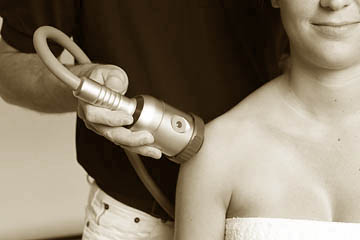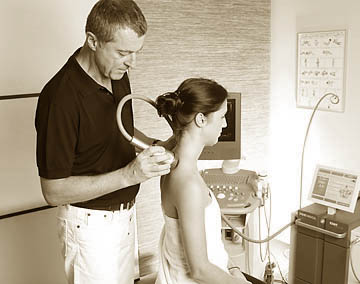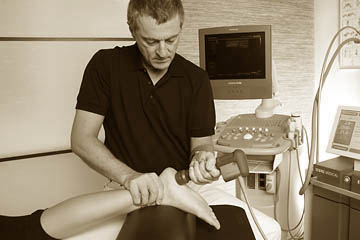Extracorporeal shock wave therapy
|
Extracorporeal shock wave therapy (ESWT) is an innovative and successful method of treating a variety of painful conditions. With the aid of this therapy pathological changes to tendons, ligaments, joint capsules, muscles and bones can be eliminated. The method is particularly popular in the USA for getting rid of cellulites. In shock wave therapy the diseased tissue is bombarded with high-, combined with low-energy ballistic radial shock waves. This stimulates metabolism and improves blood circulation to the area of treatment, which in turn facilitates self-healing without additional drug administration. |
 |
|
Do you suffer from acute or chronic pain in muscles, tendon attachments, the shoulder or heel? Do you have a long history of headaches or chronic back pain that considerably restricts movements and the quality of your life? ESWT is a modern, highly effective method of pain management. In particular, chronic stress damage to tennis or golf elbow, as well as shoulder calcification and heel spur can be treated with focused high-energy extracorporeal shock wave therapy. New is the possibility of treating posture disorders, myofascial syndrome and disturbed movement patterns with trigger points, as well as removing cellulites. Treatment with ballistic (radial) shock waves is not only possible for chronic symptoms but also for acute complaints. It is particularly effective in the treatment of acute sports injuries involving muscles and tendon strains. We operate a modern shock wave device and have many years of experience in the field. Dr. Surminski is member of a German speaking international society for extracorporeal shock wave therapy (DIGEST). Which complaints can be treated?
|
Clinical practiceA shock wave applicator is moved across the painful area, controlled, if necessary by means of an ultra sonic device. The treatment itself lasts 20 to 30 minutes. Therapy usually stretches over 4 to 6 sessions, some chronic conditions require up to 10 sessions 1-2 times weekly. Most patients notice a definite improvement eight to ten days after the first treatment session, although in some cases this can take up to 10 to 12 weeks.
|






